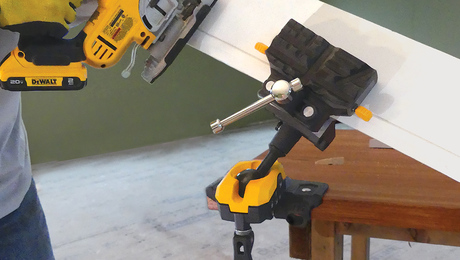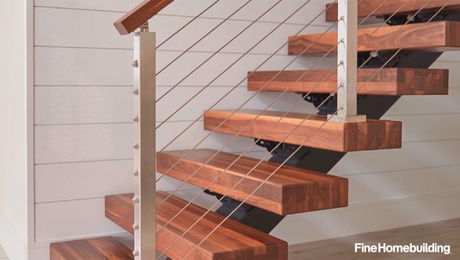A mind is a terrible thing to waste.

Hi,
You’ve heard of “dumb” and “dumber?” Well here’s “dumbest”. . .
The other day I fastened my first wainscoting cap, thinking how cool I was to be using a piece I had fashioned myself with my trusty router, and what a thoroughly professional job I was making of it. My, I thought to myself smugly, that looks downright pro.
So I go to clean off the dust prior to applying some finish this morning and notice something protruding at the back of the cap. Hmmm, must be a little woodchip or something–uh, actually, heh-heh, that looks strangely metallic, rather similar to a 6d bright finish nail, as a matter of fact.
Sure enough, Mr. Mental Giant Among Men had nailed at too high an angle when fastening a strip of moulding where the bottom of the cap meets the wainscoting, and the nail had come up right through the back edge of the cap and into the sheetrock. Ouch.
And of course he had set the nail without checking first.
Question is–what’s the best way to remove or hide the nail without totally butchering the cap? I thought about digging the out the sheetrock to expose the point of the nail and trying to back it out, but that sounds like a recipe for disaster. Then I thought about cutting the nail off just where it exits the cap (right on the corner) but with what?
Please save myself from my stupidity.



















Replies
How about a Dremel tool with one of those tiny cut off wheels? I'm sure you'd have to do a bit of patching afterwards, but not too much I'd think. Or perhaps a very thin stiff blade like an old putty knife driven in flat to force it down and flush?
Thin straight punch and push it straight thru.
Here fishy fishy....
You mean drive it right on through from the head side (and out the top of the cap)?
Yup
Here fishy fishy....
You may be able to grab it with a pair of vise grips and pull it thru or with the aide of a hammer tap on the vise grips so that you don't have to pry against anything. I believe thru is the best answer.Life is not a journey to the grave with the intention of arriving safely in a pretty and well preserved body, but rather to skid in broadside, thoroughly used up, totally worn out, and loudly proclaimingWOW What a Ride!
You used the wrong format for asking for help in a situation like this.
The correct format is:
"This guy I know is having trouble with some wainscoting..."
A waist is a terrible thing to mind.
I agree with PaulB.
A Dremel tool will do the job. When I built a kayak, I nailed the deck onto the hull, and the nails I used (copper roofing nails) were a little too long. The sharp tips poked through the sheer clamp into the interior passenger area. I couldn't reach them with wire cutters, a file, or a sander; so I grabbed the Dremel. I used the small "drum" style grinding wheel to grind them down. They were copper so it went pretty fast. I had to grind off at least a dozen of them. Your steel nails will take longer, but a few minutes on each nail, and you can grind them flush with the surface of the drywall. Then a dab of paint will cover them. The one thing I ran into, that you should watch if you try this, is that they got really hot from the friction of grinding them down.
A Dremel tool is a cheap POS in most situations, but is perfect for something like this.
If this is paint grade, take a nail set and set the exposed shank of the nail into the cap. May take several locations to bury it completely. Fill the area with filler, sand, prime and paint. Gotta admit, I've had to do the same thing, and burying the nail into the trim worked for me; couldn't tell it was there when I was finished.
If it's stain grade, I might try to pry the cap off a little to get the head of the nail exposed, then use a cats paw to remove.
Good luck.
A cats paw? on stain grade? give me a break!
I agree with the thin straight punch. I keep just such a thing in my pouch for chasing wayward finish nails. But a cats paw? Geeez
With a putty knife between the paw and trim, it works without damaging the wood.
I never met a tool I didn't like!
I can't see a cat's paw either. Unless it's surgical grade, no way it won't eat something up. I've taken wire cutters, gripped the exposed portion of the nail (careful not to cut the nail when gripping) then tap with a hammer on the flat backside of the cutter following the angle of the nail. You'll have to keep grabbing at it with movement but this does nothing more in damage than needing a bit of mud, cursory sand, then prime/paint to cover the peripheral damage. You'll dent the sheetrock a bit this way but leave the trim virtually unscathed providing you're careful. The pin punch idea is good too but toward the end, it gets tough pulling the punch out without wallering the hole. My preference is to damage sheetrock before comparable damage to wood.
Edited 3/15/2004 7:06 pm ET by Homewright
Cat's paw... CRINGE!!!Life is not a journey to the grave with the intention of arriving safely in a pretty and well preserved body, but rather to skid in broadside, thoroughly used up, totally worn out, and loudly proclaimingWOW What a Ride!
sidecutters. I always have a pair in my pouch when I'm using the trim nailer.
Don't beat yourself up too bad. it's amzing how often a knot or another nail or screw will turn a finish nail out of the wood.
You don't want to be holding it with fingers too close either, I had an 8d 15ga go an inch ionto my thumb onece like that. I was a part of the gazeebo!
Had anothe one hit a knot and curl right out under the driver into a perfect circle.
Welcome to the
Taunton University of Knowledge FHB Campus at Breaktime.
where ...
Excellence is its own reward!
Ed,
I think you got the right answer right off the bat. PaulB's idea of the Dremel with a cut off wheel is exactly the tool for this situation. Although it might be helpful to have the flexible extension if the angle is difficult.
Rich Beckman
Another day, another tool.
I have an old Dremel tool I can dig out--was thinking about that as a possible solution, although it will take a damn steady hand to avoid gouging the wood.
Piff, pardon my ignorance, but what exactly are "sidecutters"?
Probably a pair of diagonals
This is a job for the nippers.
The pliers looking things that seem like ought to be used for pulling horse teeth.
Best nail pulling tool around.
Wire cutters.
Dremel sounds like the plan.... You can do it...
Piff is right about the nails turning...Life is not a journey to the grave with the intention of arriving safely in a pretty and well preserved body, but rather to skid in broadside, thoroughly used up, totally worn out, and loudly proclaimingWOW What a Ride!
"Piff is right about the nails turning..."
Right you are....... every since the advent of the pneumatic finish nailer......
....and colored putty......
Does anyone hand drive, or blunt the tip, or predrill the tough ones, or lift a chip?
Predrill or lift here...Life is not a journey to the grave with the intention of arriving safely in a pretty and well preserved body, but rather to skid in broadside, thoroughly used up, totally worn out, and loudly proclaimingWOW What a Ride!
I like your quote about life! " Life is either a daring adventure of nothing at all". Is sort of mine.
Depending on the finish I have a very small custom made chisel for just such an occasion ' I know chisel and nail shouldn't even be in the same sentence, however this is my brad and small nail cutting chisel. A quick sharp smack and the nail is either cut in half or cut pretty deeply so as to allow the needle nose pliers to bend/break the rest off. usually doesn't even touch the wood. My 2 cents anyway. Best of luck! Miami
Concerning the thread title... I fit that bill...
The tag line... That too..
The chisel and nail thing not a chance....Life is not a journey to the grave with the intention of arriving safely in a pretty and well preserved body, but rather to skid in broadside, thoroughly used up, totally worn out, and loudly proclaimingWOW What a Ride!
Does anyone hand drive, or blunt the tip, or predrill the tough ones, or lift a chip?
Until just recently I had a nail spinner that I used for tough situations. You chuck the spinner in your screw gun and insert the head end of a hand finish nail then spin the nail 3/4 of the way into the wood. finish up with hammer and set. Works great especially in hardwoods. Does anyone know where I can get another one?
or blunt the tip, You're talking about air nails, right? I have had a rash of curled 16ga nails recently. Bummer. I have considered holding the strip of nails against a belt sander to square the ends before use.
Whenever you are asked if you can do a job, tell'em "Certainly, I can!" Then get busy and find out how to do it. T. Roosevelt
The craftsman formerly known as elCid
Actually, I was referencing the hand nailing technique.
But, having similar curling nail problems where the air nails follow the annular ring pattern, I make it a point to (try) to remember to turn the gun so that the chisel point is at right angles to the rings, allowing the point to cut through the denser ring rather than turning.
Most of the time it works and the nail goes where you plan.
If the nail point comes back out of the work and can be grabbed securely by any means, I just grab and bend it back and forth until it fatigues and breaks off.
99.9% of the time the break is below the surface of the exit wound and if you are not too aggressive in your bending the hole will not be so enlarged that it cannot be disguised. Any attempt to back out an air driven nail usually ends up boogering the work.
I'm chiming in on the side of the Dremel advocates. I'm a VERY experienced screw-up, and have made a mess of an endless number of things during my 57 years of practicing making mistakes. I've generally found that continuing to hit things that are already in the wrong place makes more wrong things happen, and, in the situation you describe, backing the thing out will most probably result in more tear out and movement someplace (for instance, it will look o.k. where you are working, but you'll notice later it pulled the other end away from where it was supposed to be). So I vote against any form of hitting, pushing, or pulling in this situation. The Dremel with a cut-off wheel (you'll bust three of them cutting the nail, but they're cheap) will get rid of the nail with little visible damage and, most importantly, won't trash anything else.
In carpentry, as in everything else, our first duty is to take the Hippocratic oath, or at least the first line of it: "First, do no harm."
I agree, my instincts here are to take the surgical approach for just the reasons you mention--namely, compounding the problem and ending up having to rip the whole cap off, mill a new one, and start over.
Incidentally, I wish I could blame this on the nail gun but in fact I hand nailed it into a predrilled hole--just was careless with the angle on this particular one. What really chaps my hide is that I didn't flippin' look carefully before setting the nail. It would've been a ten second fix at that point.
If you don't already, spring the extra couple of bucks to buy the "heavy-duty" reinforced cut-off wheels rather than use the type that came with your Dremel. Wear longer, break far less often..
Phill Giles
The Unionville Woodwright
Unionville, Ontario
This happens alot in cabinetmaking while attaching moldings, etc. The thin steel nail will follow the annual rings of the wood , sometimes coming out 90 degrees or more from your intended direction. Or sometimes you just screw up. The best tool for getting it out is a nipper. Looks like an all purpose fencing tool or a pair of dikes with the cutters on the front instead of the side, with the cutter face almost milled flush. It allows you to grab the nail and pull it thru from the front. If you try to push it back out intead of pulling it will cause alot of tearout. Dan019
I recall a while back FineHomebuilding printed a short article by a guy who was shooting trim when he said it felt like he got stung by a bee in the chest.
Apparently a nail had hit a knot and curled back exiting the wood and into his chest.
So he casually walks into the ER to have them check it out when he notes a sudden flurry of activity among the staff.
Come to find out the nail had penetrated so close to the heart that a wrong movement on his part could have had serious complications.
Grains and knots.
I've used every one of the above notions for this sort of problem EXCEPT the cat's paw. (Jeez……….on a finish nail??!! Must have a different unit than mine.)
Nippers are good, sometimes side-cutters, so is the right sized punch, so is the cut-off wheel. But here's another that can be used in the right situation.........electric soldering iron. Place the tip of the iron on the tip of the nail or busted screw to be removed and heat things up until the wood immediately around the fastener has "given way" to the heat and the fastener has once again cooled. Remove offending nail or screw.
When to use this technique is up to the practitioner of same.
Knowledge is power, but only if applied in a timely fashion.
Man, that is novel.
Dogbones to Goldhiller.
Thats the trick I use to remove frets from Guitars and Basses..never thought about nails..good thinkin.
View Image
Spheramid Enterprises Architectural Woodworks
Repairs, Remodeling, Restorations.
Same size drill bit as the nail.
Drill clear through.
I've done it a buncha times with no muss or fuss
"My life is my practice"
Pin punch, drive it through. Bury it in the drywall. Patch the drywall.
I have a 16 gage nailer and the nails bend if I hold the gun parrallel to the trim(points follow the grain) but the chisel points cut the grain if held perpendicular to the trim.
Nail spinners work nice with hand driven finish nails.
Just my 2 cents.
Harpo
PS For broken screws they make a hollow 1/4" drill bit with teeth around the end. Looks like a thin hole saw. Drill around the screw stub, remove core, plug the hole. Used it in boat repair a lot.